ISSN ONLINE(2319-8753)PRINT(2347-6710)
ISSN ONLINE(2319-8753)PRINT(2347-6710)
Dr. Neeraj Bhargava 1, Anchal kumawat 2, Dr. Ritu Bhargava3
|
| Related article at Pubmed, Scholar Google |
Visit for more related articles at International Journal of Innovative Research in Science, Engineering and Technology
there is increased interest in the use of barcodes to encode more information per area unit than regular, black and-white barcodes. A barcode is series of bars and spaces arranged according to a set of rules that determines how data is to be represented where as 2D Barcode Stored data in non-linear fashion, such codes known as twodimensional code. Here various applications have been discussed in brief and also the structure, symbology and properties of barcodes. This research paper deals with the facility to generate QR barcodes with help of document software such as ms-word document 2007/2010. Main goal is to achieve creation and understanding the technology of QR code in today’s environment
Keywords |
| QR code; strokescribe. |
INTRODUCTION |
| QR (Quick Response) codes are two-dimensional bar codes that can contain any alphanumeric text and also consist data in binary form , it may be in only numeric form , Kanji format and often feature URLs that direct users to sites where they can learn about an object or place (a practice known as “mobile tagging”). Decoding software on tools such as i phones camera, tablet interprets the codes, which represent considerably more information than a one-dimensional code of similar size. The codes are increasingly found in different places like buildings, product labels, billboards, and inviting passers-by to pull out their mobile phones, uncover the encoded information. Codes can provide tracking information for products, routing data on a mailing label, or contact information on a business card. Small in size, the code pattern can be hidden or integrated into an esthetically attractive image in newspapers, magazines, or clothing. QR Code (Quick Response Code) is the trademark for a type of matrix barcode (or two-dimensional code) first designed for the automotive industry. More recently, the system has become popular outside the industry due to its fast readability and large storage capacity compared to standard UPC barcodes. The code consists of black modules (square dots) arranged in a square pattern on a white background. The information encoded can be made up of four standardized kinds ("modes") of data (numeric, alphanumeric, byte/binary, Kanji), or through supported extensions, virtually any kind of data. Unlike the old bar code that was designed to be mechanically scanned by a narrow beam of light, the QR code is detected as a 2-dimensional digital image by a semiconductor image sensor and is then digitally analyzed by a programmed processor. The processor locates the three distinctive squares at the corners of the image, and normalizes image size, orientation, and angle of viewing. The small dots are then converted to binary numbers and validity checked with an error-correcting code [3] [5] [6][11][12]. |
II. LITERATURE SURVEY |
| QR Code is a matrix symbology consisting of an array of nominally square modules arranged in an overall square pattern, including a unique finder pattern located at three corners of the symbol and intended to assist in easy location of its position, size and inclination. A wide range of sizes of symbol is provided for together with four levels of error correction. Module dimensions are user-specified to enable symbol production by a wide variety of techniques. QR Code Model 1 is the original specification for QR Code; QR Code Model 2 is an enhanced form of the symbology with additional features and can be auto-discriminated from Model 1. Since Model 2 is the recommended model for new, open systems application of QR Code, this International Standard describes Model 2 fully, and specifies the features in which Model 1 QR Code differs from Model 2 in annex [2]. |
| ïÃâ÷ ISO/IEC 18004: ISO Standard on QR Code 2005 Bar Code Symbology Specification |
III. OBJECTIVE |
| Consequently, QR codes are a convenient way to add the virtual to the physical to provide useful content, often at the time of need and it’s storage capacity accommodates a variety of data beyond numbers including Text, Hyperlink, Telephone number (Phone call), SMS/MMS message, Email (Send message) etc. The main objective of this research paper is to increase the QR code awareness, find the benchmarking of different codes and implementing this QR code feature with the help of ms word 2007. Also promote it for educational purpose and several other criteria like medical, marketing, finance and information about different products containing less space. |
IV. QR CODE STRUCTURE |
| QR Code is a matrix type symbol with a cell structure arranged in a square. It consists of the functionality patterns for making reading easy and the data area where the data is stored. QR Code has finder patterns, alignment patterns, timing patterns, and a quiet zone [1]. |
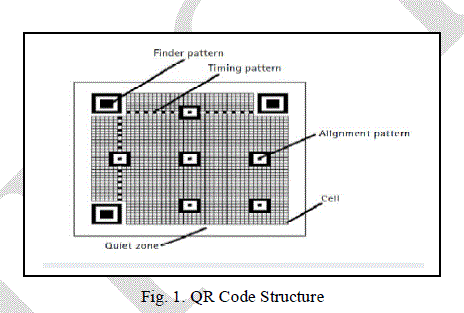 |
| 1. Finder Pattern |
| A pattern for detecting the position of the QR Code. By arranging this pattern at the three corners of a symbol, the position, the size, and the angle of the symbol can be detected. This finder pattern consists of a structure which can be detected in all directions (360°). |
| 2. Alignment Pattern |
| A pattern for correcting the distortion of the QR Code. It is highly effective for correcting nonlinear distortions. The central coordinate of the alignment pattern will be identified to correct the distortion of the symbol. For this purpose, a black isolated cell is placed in the alignment pattern to make it easier to detect the central coordinate of the alignment pattern. |
| 3. Timing Pattern |
| A pattern for identifying the central coordinate of each cell in the QR Code with black and white patterns arranged alternately. It is used for correcting the central coordinate of the data cell when the symbol is distorted or when there is an error for the cell pitch. It is arranged in both vertical and horizontal directions. |
| 4. Quiet Zone |
| A margin space necessary for reading the QR Code. This quiet zone makes it easier to have the symbol detected from among the image read by the CCD sensor. Four or more cells are necessary for the quiet zone. |
| 5. Data Area |
| The QR Code data will be stored (encoded) into the data area. The grey part in Figure 11 represents the data area. The data will be encoded into the binary numbers of ‘0’ and ‘1’ based on the encoding rule. The binary numbers of ‘0’ and ‘1’ will be converted into black and white cells and then will be arranged. The data area will have Reed-Solomon codes incorporated for the stored data and the error correction functionality. |
V. WORKING OF QR CODE |
| The process of scanning, decoding and reading out the content of a 2D barcode, such as a QR code, using a camera phone is known as mobile tagging.4 In order to read a QR code one must have a QR code scanner. These scanners come built into various camera-enabled mobile phones and third party scanner applications can be downloaded to almost any smart phone. After taking a picture of a QR code, the application processes the code and converts it into readable text. The code might contain contact information or a URL for a company’s website. To create a meaningful and interactive customer experience, QR codes can be programmed to start up applications such as web browsers, IM, email, SMS and even streaming video [2]. |
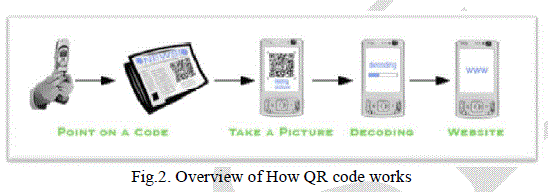 |
VI. VARIATIONS OF QR CODES |
| Here several variations of 1D and 2D barcodes shown as in fig.3. |
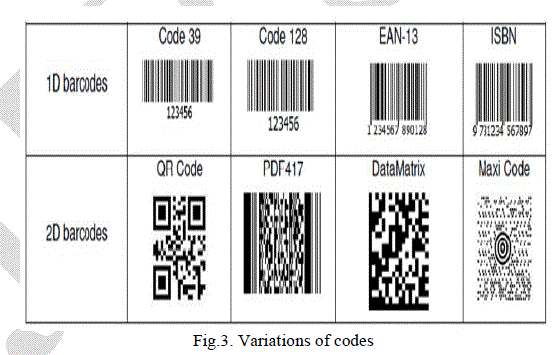 |
VII. APPLICATIONS OF QR CODE |
| QR Codes are now used over a much wider range of applications shown as in fig.4., including Vcard information, tattoo, commercial tracking, ticketing, entertainment and transport ticketing, product/loyalty marketing and in-store product labeling. It can also be used in storing personal information for use by government. Many of these applications target mobile-phone users (via mobile tagging). Users may receive text, add a vCard contact to their device, open a Uniform Resource Identifier (URI), or compose an e-mail or text message after scanning QR Codes. They can generate and print their own QR Codes for others to scan and use by visiting one of several pay or free QR Code-generating sites or apps that shown as in fig.4 [8] [9] [10]. |
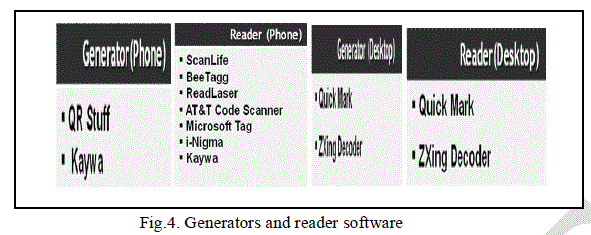 |
VIII. METHODOLOGIES |
| As we describe in this research paper we must have stroke scribe as well as QR code or Barcode Scanner to check it available information. After this we can use the below steps to generate QR Code through Microsoft word 2007.We can also save this QR code image on our disk. |
| Step 1. Firstly start Microsoft Word 2007 using Start button->All Programs menu. |
| Step 2. From insert tab, find text tool group and then select object option from it. |
| Step 3. In the Insert Object dialog, select stroke scribe document option from the object type list such as shown in fig.6. |
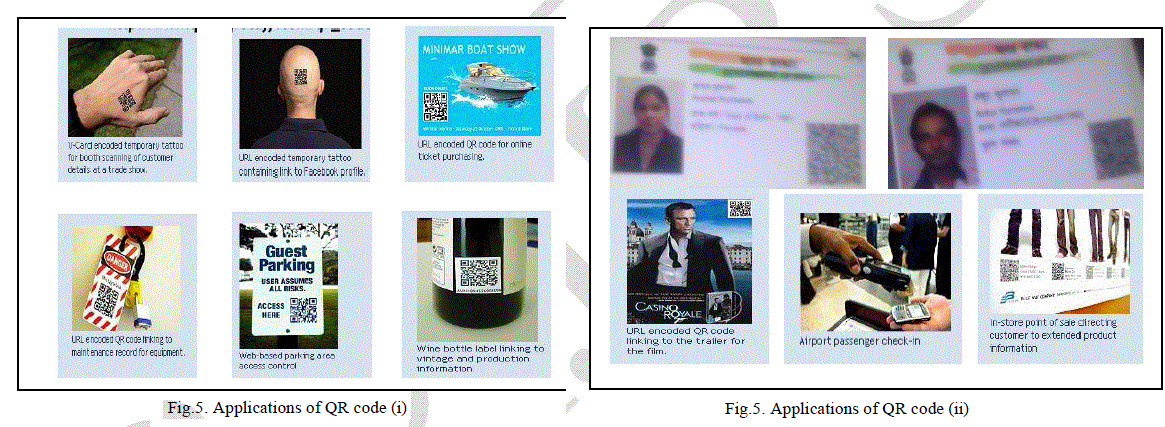 |
| Step 4. After step 3 by default the following bar code will be shown as in fig.7. |
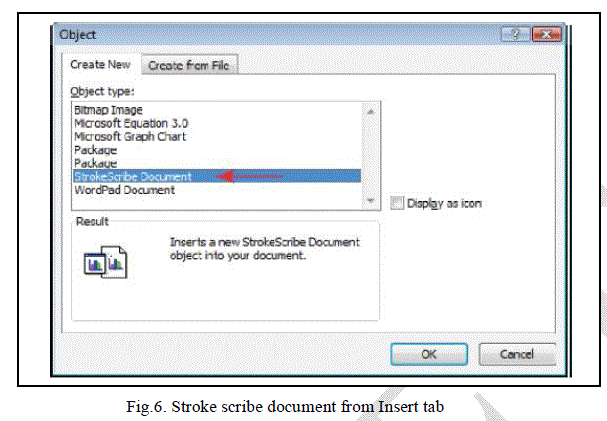 |
| Step 5. Perform Right-click event on the barcode picture to open the context menu to choose the StrokeScribe Control then from next pop up select properties option. The way as shown in fig.8. |
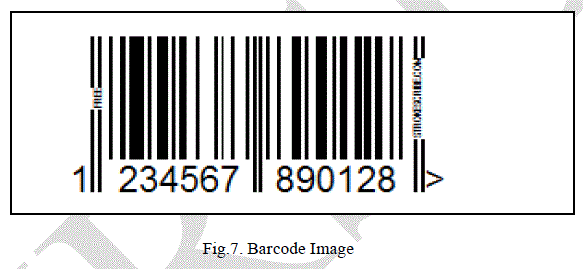 |
| Step 6. Select the barcode type and adjust barcode property that we want as shown in below fig.9.we can change the text, color, rotation, code type i.e. alphabet. |
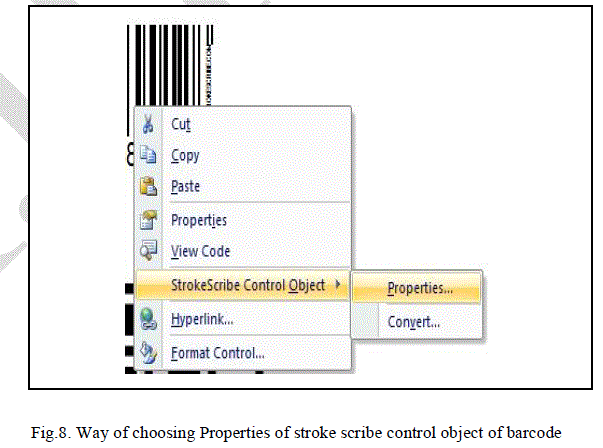 |
| Step 7. To generate QR code then select QR code Property from alphabate option. Instead of QR code we can make several codes by selecting properties of object such as in fig.10. |
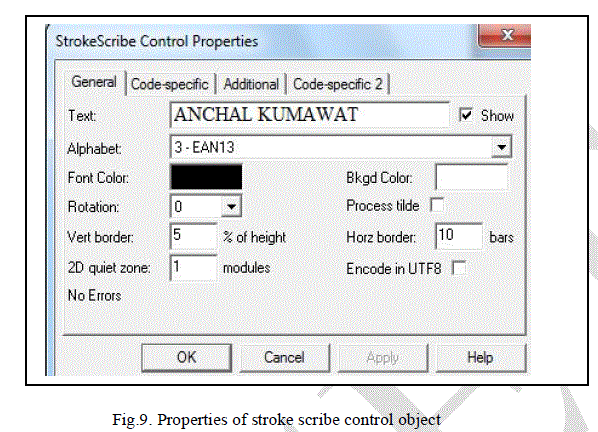 |
| Step 8. Finally we can get QR code of our generating text such shown as in fig.11. |
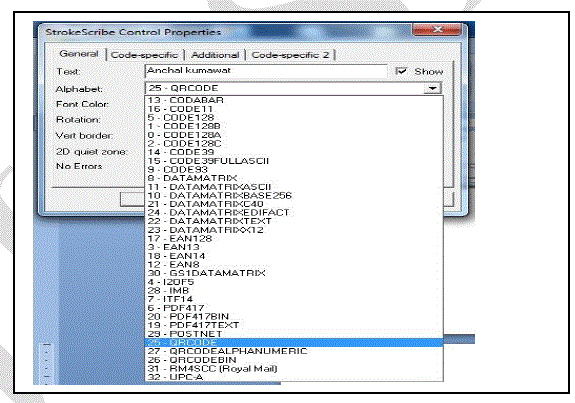 |
IX. CONCLUSION |
| This research paper analyze that generation of a QR code with the help of document software. A general user can generate own QR code of their text in a user friendly environment of word and a user can generate for this by following above steps given in this research paper. To scan Fig 11 QR code through different iphones reader like scan life ,bee tagg and so on and desktop readers like Quick Mark and Zxing decoder and then information will be displayed on user’s iphone or desktop. |
References |
|